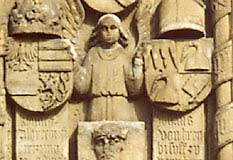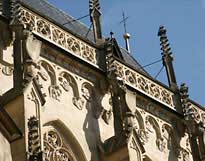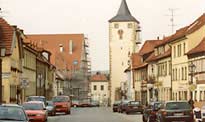|
|
 |
 |
 |
|
 Hassfurt Hassfurt
The "Ritterkapelle" |
|
The "Ritterkapelle” – also called "Marienkapelle” – is one of the most important architectural monuments of the late Gothic era in eastern Lower Franconia. A fraternity, which was founded by the curate general of Wuerzburg and high priest of Hassfurt Dr. Johannes Ambundii and Knight Dietrich Fuchs of Wallburg, was donator of that church building. Members of that fraternity have been clergymen and noble lay persons of both sexes.
|
|
 |
|
|
|
 |
|
| The "Ritterkapelle” was erected outside the city wall in a place where the "Marienkapelle” was located in former times (since early 14th century). Contemporaneous with the building of the city’s parish church the laying of the foundation and the start of construction of the chapel’s choir took place in 1390. The building of the nave – as can be inferred from an inscription on the southern wall of the nave – was even set about 41 years later. Another inscription on the south wall of the chapel and the tympanum of the side entrance both name the year 1455. So art historians came to the conclusion that the entire construction project was finally brought to an end in 1455. The arch of the choir probably was constructed between 1455 and 1466: The coat of arms of Johann III of Grumbach (1455–1466) prince bishop of Wuerzburg is bearing the symbol of keystone of the chapel’s vault. The "Ritterkapelle” finally was completed at the beginning of the 16th century. |
|
|
|
|
|

|
|
|
|
Local History of Hassfurt |
|
1230 Hassfurt is proved by documents for the first time as "hasefurthe”.
1235 Prince bishop Hermann I of Lobdeburg gives municipal law to the city of Hassfurt.
1407 Hassfurt becomes mint and receives the right to mint coins.
1514 New building of the town hall at the marketplace.
1814 During the regency of King Max Josef I Hassfurt joins the Kingdom of Bavaria. |
|
|
|
 |
|







